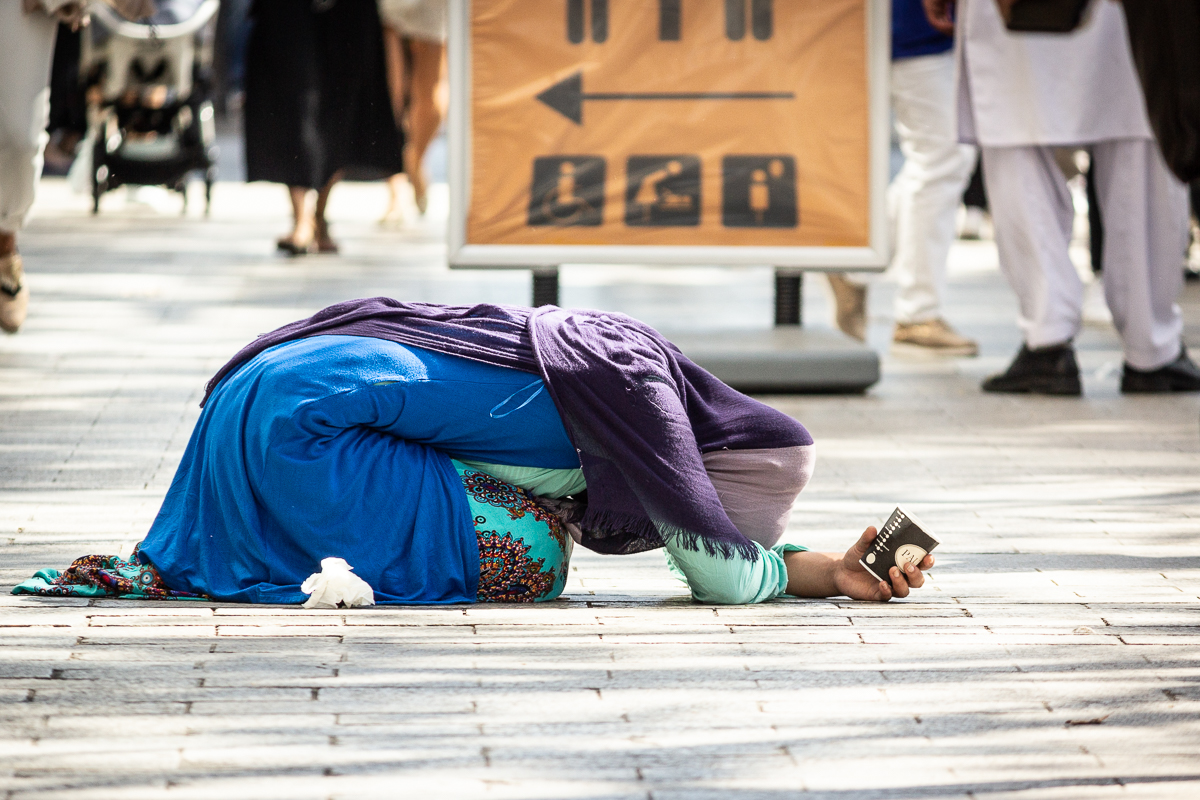Europe
Europe's New Beggars
An elite discourse condones destructive behavior and reinterprets a denigrating hand-to-mouth existence as an alternative lifestyle

Recently my wife and I walked along the fashionable shopping street Avenue Montaigne, situated between Place de l’Alma and Champs Elysées in one of the most affluent Parisian districts. Passing the elegant window fronts of Chanel, Givenchy, Jimmy Choo, Luis Vuitton, Prada, Valentino, and YSL, we noticed a woman and child half-lying on the pavement in tattered clothes, appealing to passersby for money. While it was a particularly appalling sight in this prosperous setting, it was not an anomaly in the urban fabric of Paris. Such expressions of extreme poverty and deprivation have, in fact, become sadly familiar features of most Western European cities of late.
Indeed, as a result of the European Union’s eastward expansion during the previous decade, and the principle of free movement of persons within the E.U., thousands of rough sleepers, mostly ethnic Roma from the ex-socialist countries Bulgaria and Romania, have arrived in the streets, parks, and playgrounds of the E.U.-15 countries.
Contrary to the purpose of free movement, most have not come to work or study, but to beg in the most abject manners. France is perhaps the most notorious country for child begging in Western Europe, but even in more child-friendly societies in Scandinavia, we see children of 13 and younger being used for begging by adult family members. Other beggars display, or, more often, simulate, physical disabilities to evoke compassion. For instance, a beggar encountered in Hamburg by the German Der Spiegel magazine “learned how to be a good beggar on his first day in Germany. […] At the beginning of his lesson, he was told to put on two old sweaters and was given a blue crutch so that he could practice walking with it. He would throw his left leg further forward than his right, causing his hips to buckle as he stumbled across the grass.” Depressingly, the same feigned convulsing can be observed in Barcelona, Rome, and almost any other Western European city.
It is important to understand that this behavior is not mainly an outcome of labor market discrimination in Western Europe. For some, begging is instead the very point of migrating. As observed in a recent article in the journal Migration Studies: “In many rural Roma communities, transnational migration for begging and street work has now become an institutionalized practice, constituting the backbone of the local economy.”1 Or as a Romanian woman found begging in London’s West End explained to the Daily Mail: “I don’t beg at home. But I need money. We have a very small house and my children and three nephews all live with us. I can’t afford it. So here, I beg.” Fieldwork conducted among Cortorari Roma in Italy even suggest that the very notion of traveling abroad, for some, is associated with begging.2
For others, often including the very young, the elderly, and persons with mental disabilities,3 begging is a consequence of coercion and deceit. In the particular case that Der Spiegel describes, a Romanian family had lured people from their village to Hamburg under the guise of a better life in Germany and then forced them to beg.
Similar examples of trafficking for the purposes of forced begging are abound. In Norway, a state television investigation two years ago exposed a large Romanian trafficking ring of 140 individuals in the city of Bergen, whose leaders regularly posted pictures of the jewelry and luxury cars that their activities (extending to using begging as a front for prostitution) afforded them on social media. More recently, seven Bulgarian citizens were prosecuted in southern Sweden for running an organized network of over 30 beggars, who were abused and starved when they did not “perform” satisfactorily. Nevertheless, it remains uncertain to what extent the begging phenomenon is due to coercion. According to a scholarly chapter on begging in the Routledge Handbook of Human Trafficking (2018), there is “no generalized analysis that applies to all begging situations”—and, ultimately, there are more critical aspects to be considered.
First, the social disintegration that the continued presence of beggars creates. As observed by political scientist James Q. Wilson, who together with criminologist George Kelling conceived the “broken windows” theory that visible disorder in public spaces causes a decline in social capital and a rise in criminal behavior, in Thinking about Crime (1985), the “unchecked panhandler is, in effect, the first broken window.” Moreover, the constant exposure to the deception involved in begging, such as pretending disabilities or other personal difficulties, is detrimental to social trust and reciprocity.
Secondly, but not least important, there is the debasement to the beggars themselves and the risk that the daily sight of people kneeling and sleeping in the streets will cause a mental separation of certain populations from the rest of society in the minds of ordinary citizens and teach our children that the dignity of the poor simply matters less. It has been estimated that approximately 70 percent of beggars in Oslo sleep outdoors.4 Victims of trafficking to Western Europe have also reported living in disused buses, abandoned houses, and other makeshift shelters lacking electric heat and running water.
Yet despite the fact that begging is associated with these social hazards and degrading conditions, almost all Western European states, excluding, most prominently, Denmark, have hesitated to impose or strengthen the enforcement of national blanket bans on begging as a response to the influx of foreign vagrants. In 2018, the Swedish Supreme Court allowed local municipal bans, but even that measure was intensely controversial, and thus far only a handful of rural municipalities have declared that they will take advantage of the change in legislation. The political majorities of the country’s largest municipalities have continued to defer to the public debate, in which a potential ban on begging is falsely described as “banning poverty” and withholding legitimate income from a group of people with few other means of making a living.

While such rhetoric, used by many journalists, intellectuals, and, incredibly, employees of human rights organizations, may sound appealing, it is, in fact, an example of cynicism masquerading as compassion, as we can learn from an insightful book by social thinker Myron Magnet, The Dream and the Nightmare: The Sixties’ Legacy to the Underclass (1993).
Magnet offered startling insight into the social unraveling and poverty of 1980s and 1990s urban America, strangely coinciding with the boom years of U.S. capitalism. As in today’s Western Europe, the contrasts could be stark even within the same city block:
In New York City, directly under the windows of the treasure-crammed five-million-dollar apartments that loom over glittering Fifth Avenue, for instance, sleep the homeless, one and sometimes two to a park bench, haggard, usually ill, huddled in rags turned dead gray with dirt and wear. […] As for the urban parks and pillared train stations that speak of a once-confident civic pride and prosperity, how often are they now—graffitied, vandalized, reeking of human waste—but dreary gauntlets of beggary?
In Magnet’s judgment, these and other social pathologies, such as family breakdown in the African American community and the rise of a non-working urban underclass, were not due to lack of economic opportunity, which was greatly expanding at the time. Instead, they were an inheritance from the 1960s counterculture. In particular, Magnet pointed to the counterculture’s ethos of uninhibited individual freedom, its rejection of civilizing bourgeois norms and virtues, and the era’s celebration of victimhood mentality. Handed down by an elite of opinion makers, these new values “withdrew respect from the behavior and attitudes that have traditionally boosted people up the economic ladder” and encouraged those already on the margins of society to lead calamitous lives in the nation’s cities.
In one emblematic example, Magnet showed how the widespread homelessness among the mentally ill could be traced back to the anti-psychiatry movement of the 1960s and 1970s and the influential works of writers such as Thomas Szasz, Erving Goffman, Ken Kesey, and R.D. Laing. According to Magnet, these authors maintained that sufferers of mental illness were a kind of political prisoner to an unjust social structure and that they were “really just marching to a different drummer and should be free to do their marching in the streets,” and so paved the way for the wholesale deinstitutionalization of mentally ill individuals in the U.S. When many of them ended up homeless and alone, posing a danger to themselves and sometimes to others, civil liberties activists “snuffed out any lingering possibility that the state hospitals and the community mental health centers might treat the vast majority of the seriously mentally ill” by reinterpreting their condition of homelessness as a state of emancipation.

As I have already suggested, something similar to what Magnet described is at work in today’s Western Europe. Here, too, an elite discourse condones destructive behavior and reinterprets a denigrating hand-to-mouth existence as an alternative lifestyle, ultimately discouraging governments from taking the necessary measures to maintain human dignity and alleviate the social costs of begging, such as imposing a blanket ban. The intent is to be tolerant and to do good, but the result is that the poor and marginalized are kept in their place at the bottom of society. Inadvertently, such discourse is frequently also dehumanizing. Consider, for example, the following quotations, which suggest that the function of beggars is to provide moral instruction for a complacent, affluent society.
In a long essay on the phenomenon of begging in the Swedish Svenska Dagbladet newspaper, journalist Helene Gustafsson recalled Charles Baudelaire’s poem “The Eyes of the Poor,” which chronicles the transformation of Paris in the mid-1800s, and wrote:
In Stockholm in the 2000s, Baudelaire’s poem is frighteningly current. It is no longer the boundaries to the rough quarters in the heart of the city that have been blown away. Instead, unequal terms between East and West, North and South, have been exposed, and the pleading, demanding, or empty gazes remind us yet again of our privileges, and our prosperity, the insignificance of our own concerns.
Writing in the Guardian, columnist Dawn Foster argued:
Passing a beggar who asks for money causes discomfort—and so it should. The act of facing and acknowledging human suffering and hardship on this scale ought to imprint itself on a society that has such glaring divides in income and comfort.
In similar fashion, Thomas Steinfeld, a former culture page editor of Germany’s Süddeutsche Zeitung newspaper, stated in an article published in Svenska Dagbladet that begging should not be banned partly because encountering beggars shocks us into acknowledging the “thin veneer of civilization.” However, as only a morally confused society would need to come to terms with, begging is not edifying for anyone, not least the beggar whose plight we “open-mindedly” ignore.
References
1 Friberg, J.H. (2018). Poverty, networks, resistance: The economic sociology of Roma migration for begging. Migration Studies. https://doi.org/10.1093/migration/mny038
2 Tesăr, C. (2015). ‘Begging—between charity and profession: Reflections on Romanian Roma’s begging activities in Italy,’ in Tauber E., Zinn D. (eds) The public value of anthropology: Engaging critical social issues through ethnography, pp. 83–111. Bolzano: University Press
3 National Agency against Trafficking in Persons. (2013). Trafficking in persons for begging—Romania study. https://ec.europa.eu/anti-trafficking/sites/antitrafficking/files/trafficking_in_persons_for_begging_-_romania_study_0.pdf
4 Friberg, J.H., and G. Tyldum. (2019). Migration for begging from Romania to Norway. A human trafficking perspective. Tidsskrift for samfunnsforskning, 60(1): 30–49.






